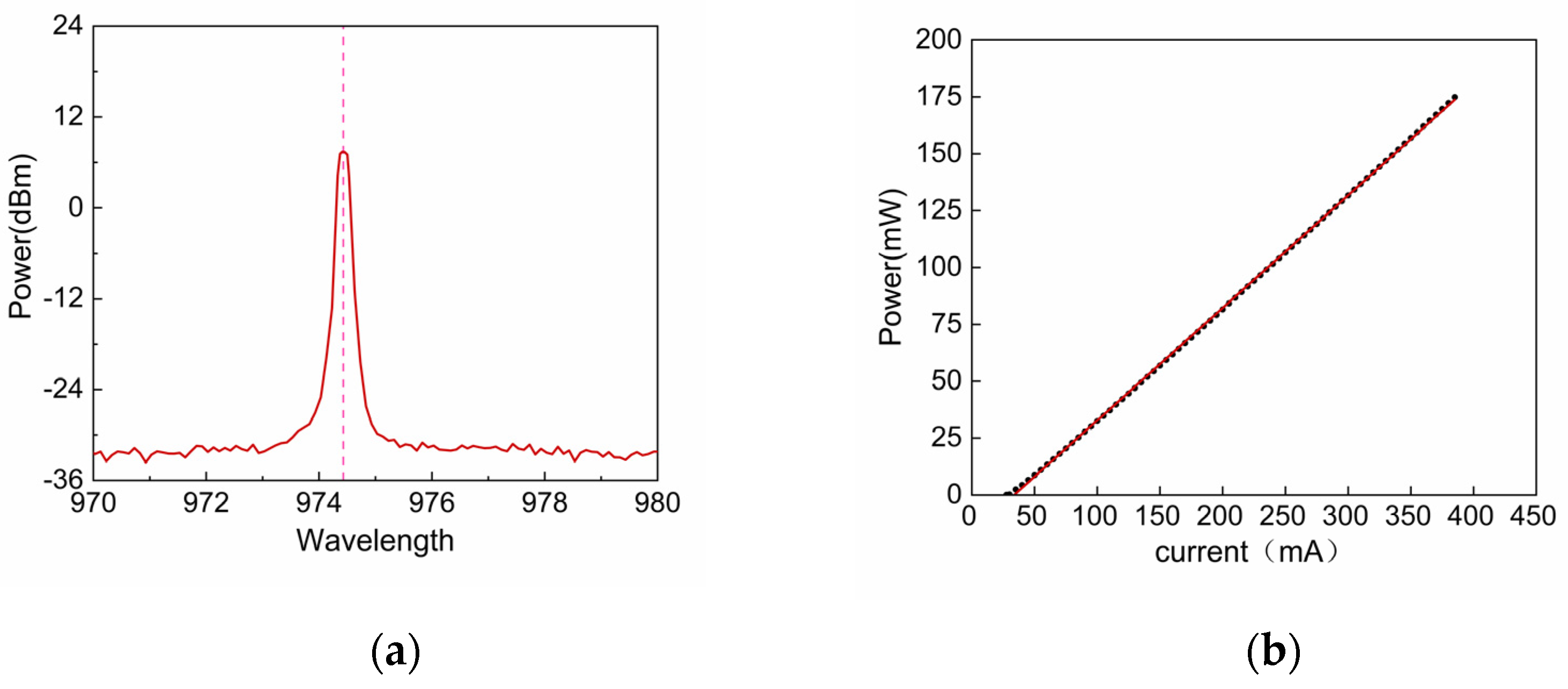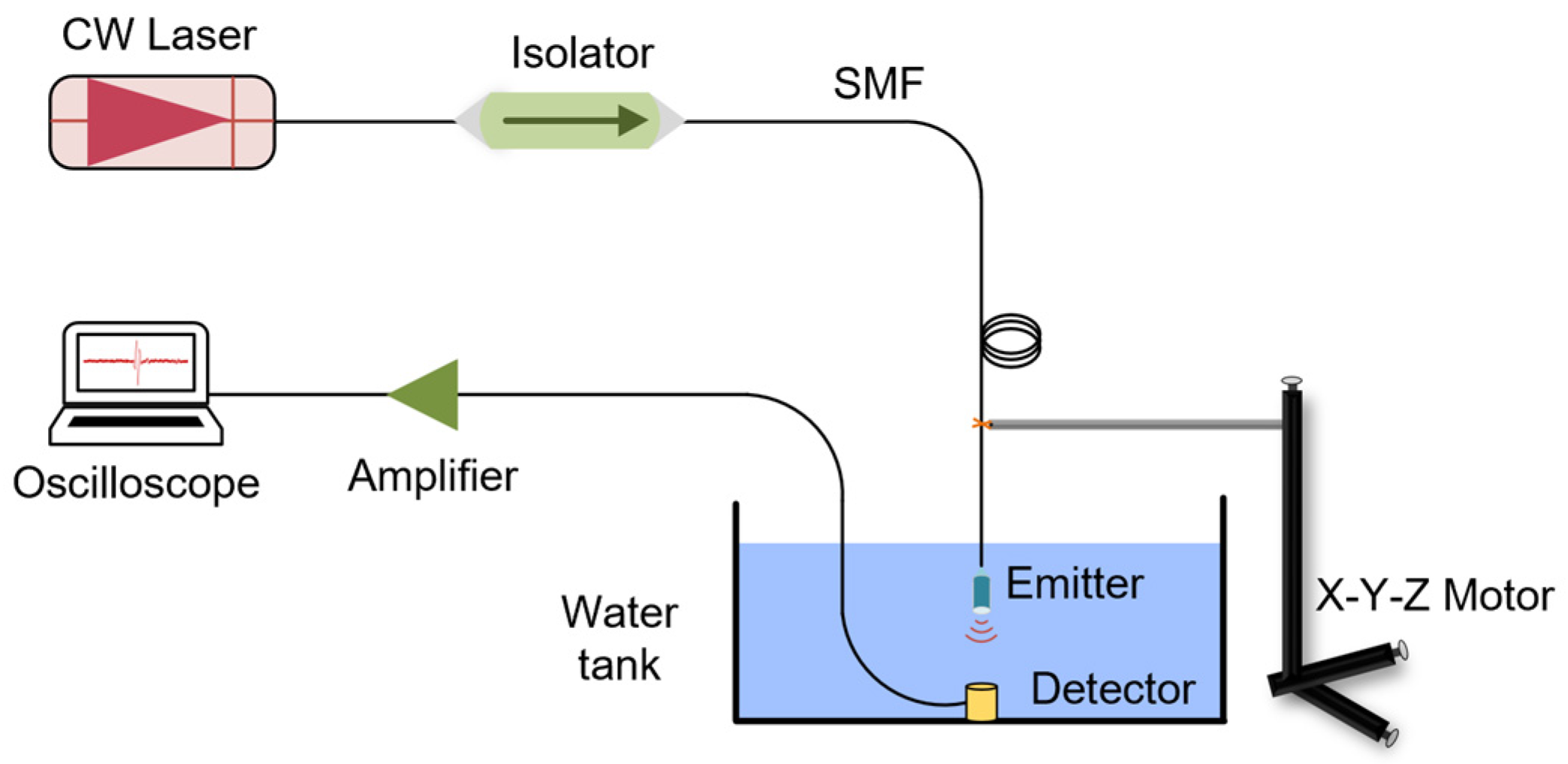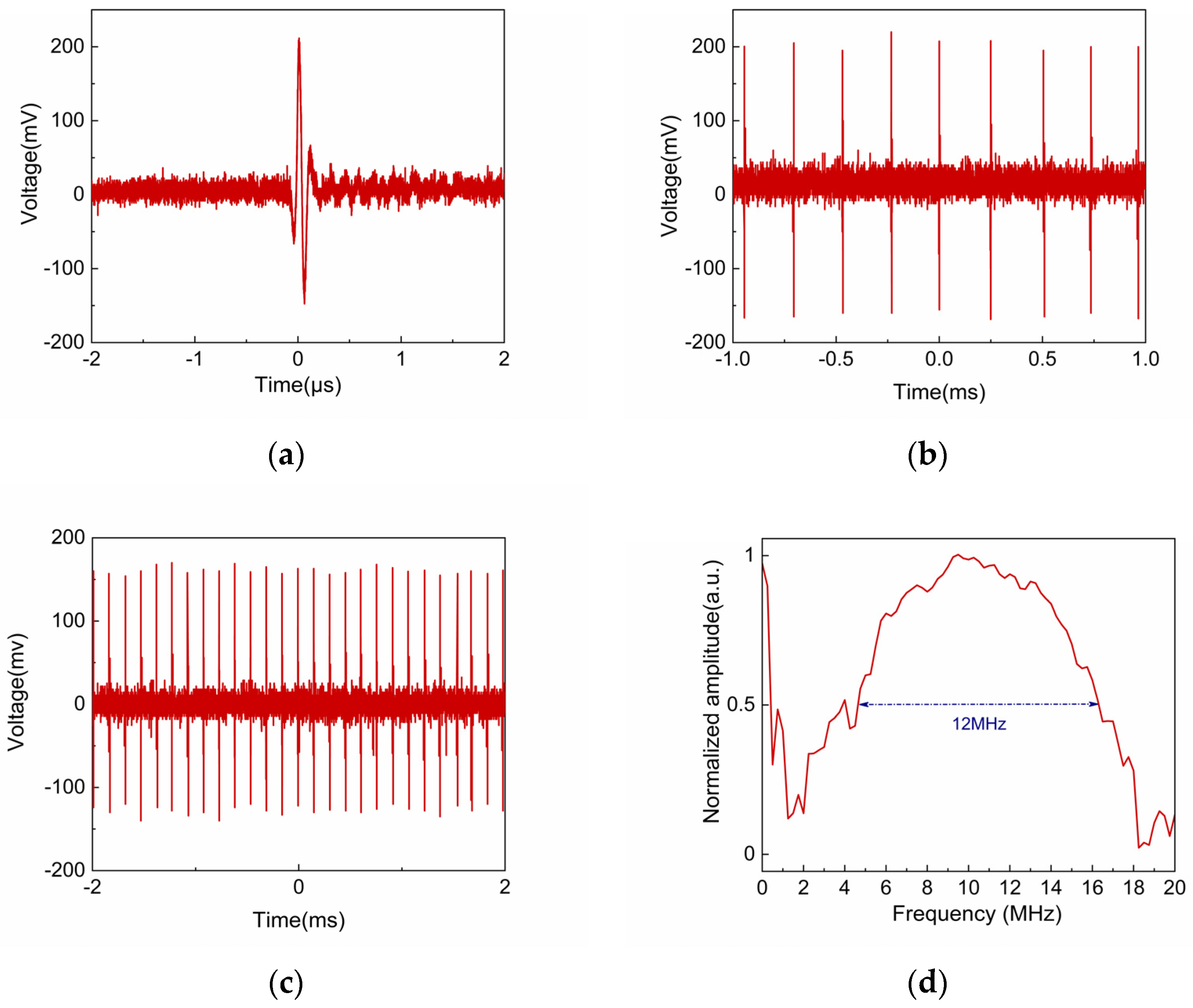An Optical Fiber Ultrasonic Emitter Based on the Thermal Cavitation Effect
Abstract
:1. Introduction
2. Theoretical Analyses
3. The Design and Fabrication of the Ultrasonic Emitter
4. Results and Discussion
4.1. Test System Setup
4.2. Results and Analysis
5. Conclusions
Author Contributions
Funding
Institutional Review Board Statement
Informed Consent Statement
Data Availability Statement
Conflicts of Interest
References
- Colchester, R.J.; Zhang, E.Z.; Mosse, C.A.; Breard, P.C.; Papakonstantinou, I.; Desjardins, A.E. Broadband miniature optical ultrasound probe for high resolution vascular tissue imaging. Biomed. Opt. Express 2015, 6, 1502–1511. [Google Scholar] [CrossRef] [PubMed]
- Huang, C.C.; Chen, P.Y.; Peng, P.H.; Lee, P.Y. 40 MHz high-frequency ultrafast ultrasound imaging. Med. Phys. 2017, 44, 2185–2195. [Google Scholar] [CrossRef] [PubMed]
- Wu, Q.; Wang, R.; Yu, F.M.; Okabe, Y. Application of an optical fiber ultrasonic sensor for nonlinear evaluation of fatigue crack. IEEE Sens. J. 2019, 19, 4992–4999. [Google Scholar] [CrossRef]
- Lee, W.; Roh, Y. Ultrasonic transducers for medical diagnostic imaging. Biomed. Eng. Lett. 2017, 7, 91–97. [Google Scholar] [CrossRef] [PubMed]
- Li, Q.; Li, J.P.; Zhu, H.B.; Chen, Y.J.; Zhu, B.P. Dynamic acoustic focusing in photoacoustic transmitter. Photoacoustics 2021, 21, 100224. [Google Scholar] [CrossRef] [PubMed]
- Xie, L.Y.; Lian, Y.D.; Du, F.J.; Wang, Y.L.; Lu, Z.W. Optical methods of laser ultrasonic testing technology in the industrial and engineering applications: A review. Opt. Laser Technol. 2024, 176, 110876. [Google Scholar] [CrossRef]
- Li, J.P.; Xu, J.B.; Liu, X.L.; Zhang, T.; Lei, S.; Jiang, L.M.; Yang, J.O.; Yang, X.F.; Zhu, B.P. A novel CNTs array PDMS composite with anisotropic thermal conductivity for optoacoustic transducer applications. Compos. Part B 2020, 196, 108073. [Google Scholar] [CrossRef]
- Zou, X.T.; Wu, N.; Tian, Y.; Wang, X.W. Broadband miniature fiber optic ultrasound generator. Opt. Express 2014, 22, 18119–18127. [Google Scholar] [CrossRef] [PubMed]
- La Cavera, S.; Pérez-Cota, F.; Smith, R.J.; Clark, M. Phonon imaging in 3D with a fibre probe. Light. Sci. Appl. 2021, 10, 91. [Google Scholar] [CrossRef] [PubMed]
- Song, W.T.; Hong, M.H.; Lukyanchuk, B.; Chong, T.C. Laser-induced cavitation bubbles for cleaning of solid surfaces. Appl. Phys. 2004, 95, 2952–2956. [Google Scholar] [CrossRef]
- Vogel, A.; Lauterborn, W. Acoustic transient generation by laser-produced cavitation bubbles near solid boundaries. J. Acoust. Soc. Am. 1988, 84, 719–731. [Google Scholar] [CrossRef]
- Ramirez-San-Juan, J.C.; Rodriguez-Aboytes, E.; Koreev, N.; Baldovinos-Pantaleon, O.; Chiu-Zarate, R.; Gutierrez-Juarez, G.; Dominguez-Cruz, R.; Ramos-Garcia, R. Cavitation induced by continuous wave lasers. NanoSci. Eng. 2007, 6644, 301–305. [Google Scholar]
- Padilla-Martínez, J.P.; Aguilar, G.; Ramírez-San-Juan, J.C.; Ramos-García, R. Temporal evolution of thermocavitation bubbles using high speed video camera. In Proceedings of the Optical Trapping & Optical Micromanipulation VIII International Society for Optics and Photonics, San Diego, CA, USA, 21–25 August 2011; Volume 8097, p. 809727. [Google Scholar]
- Zhang, B.; Banks, D.; Robles, V.; Cruz, L.F.D.; Aguilar, G. High resolution optical investigation of laser intensity and solution temperature effects on thermocavitation. Exp. Therm. Fluid Sci. 2022, 136, 110683. [Google Scholar] [CrossRef]
- Yusupov, V.I.; Konovalov, A.N.; Ul’yanov, V.A.; Bagratashvili, V.N. Generation of acoustic waves by cw laser radiation at the tip of an optical fiber in water. Acoust. Phys. 2016, 62, 537–544. [Google Scholar] [CrossRef]
- Schoppink, J.J.; Krizek, J.; Moser, C.; Rivas, D.F. Cavitation induced by pulsed and continuous-wave fiber lasers in confinement. Exp. Therm. Fluid Sci. 2023, 146, 110926. [Google Scholar] [CrossRef]
- Jackson, J.D. Classical Electrodynamics, 3rd ed.; Wiley: Hoboken, NJ, USA, 1998; pp. 35–38. [Google Scholar]
- Zaca-Morán, R.; Amaxal-Cuatetl, C.; Zaca-Moran, P.; Castillo-Mixcóatl, J.; Ramos-Garcia, R.; Padilla-Martinez, J.P. Thermocavitation: A mechanism to pulse fiber lasers. Opt. Express. 2021, 29, 23439–23446. [Google Scholar] [CrossRef] [PubMed]
- Krizek, J.; De Goumoëns, F.; Delrot, P.; Moser, C. Needle-free delivery of fluids from compact laser-based jet injector. Lab Chip 2020, 20, 3784–3791. [Google Scholar] [CrossRef] [PubMed]
- Korneev, N.; Montero, P.R.; Ramos-Garcia, R.; Ramirez-San-Juan, J.C.; Padilla-Martinez, J.P. Ultrasound induced by CW laser cavitation bubbles. In Proceedings of the 2nd International Symposium on Laser-Ultrasonics-Science, Technology and Applications, Talence, France, 5–8 July 2010. [Google Scholar]
- Vogel, A.; Venugopalan, V. Mechanisms of pulsed laser ablation of biological tissues. Chem. Rev. 2003, 103, 577–644. [Google Scholar] [CrossRef] [PubMed]
- Heng, J.; Li, C.; Chu, T.; Xu, Y.; Jian, X. A Method for High-Frequency Mechanical Scanning Ultrasonic Flow Imaging with Motion Compensation. Diagnostics 2023, 13, 1467. [Google Scholar] [CrossRef] [PubMed]
- Liu, H.J.; Wu, Y.; Hou, C.; Chen, Z.; Shen, B.; Luo, Z.; Liang, H.; Ma, J.; Guan, B.O. Ultrasound pulse generation through continuous-wave laser excited thermo-cavitation for all-optical ultrasound imaging. Appl. Photonics 2023, 8, 046102. [Google Scholar] [CrossRef]
- Ramirez-San-Juan, J.C.; Rodriguez-Aboytes, E.; Martinez-Canton, A.E.; Baldovino-Pantaleon, O.; Robledo-Martinez, A.; Korneev, N.; Ramos-Garcia, R. Time-resolved analysis of cavitation induced by CW lasers in absorbing liquids. Opt. Express 2012, 18, 8735–8742. [Google Scholar] [CrossRef] [PubMed]








Disclaimer/Publisher’s Note: The statements, opinions and data contained in all publications are solely those of the individual author(s) and contributor(s) and not of MDPI and/or the editor(s). MDPI and/or the editor(s) disclaim responsibility for any injury to people or property resulting from any ideas, methods, instructions or products referred to in the content. |
© 2025 by the authors. Licensee MDPI, Basel, Switzerland. This article is an open access article distributed under the terms and conditions of the Creative Commons Attribution (CC BY) license (https://creativecommons.org/licenses/by/4.0/).
Share and Cite
Kang, W.; Xu, D.; Xie, D.; Sheng, J.; Wu, M.; Zhao, Q.; Qu, Y. An Optical Fiber Ultrasonic Emitter Based on the Thermal Cavitation Effect. Coatings 2025, 15, 391. https://doi.org/10.3390/coatings15040391
Kang W, Xu D, Xie D, Sheng J, Wu M, Zhao Q, Qu Y. An Optical Fiber Ultrasonic Emitter Based on the Thermal Cavitation Effect. Coatings. 2025; 15(4):391. https://doi.org/10.3390/coatings15040391
Chicago/Turabian StyleKang, Wenhui, Dongxin Xu, Dongliang Xie, Jianqiang Sheng, Menghao Wu, Qiang Zhao, and Yi Qu. 2025. "An Optical Fiber Ultrasonic Emitter Based on the Thermal Cavitation Effect" Coatings 15, no. 4: 391. https://doi.org/10.3390/coatings15040391
APA StyleKang, W., Xu, D., Xie, D., Sheng, J., Wu, M., Zhao, Q., & Qu, Y. (2025). An Optical Fiber Ultrasonic Emitter Based on the Thermal Cavitation Effect. Coatings, 15(4), 391. https://doi.org/10.3390/coatings15040391



